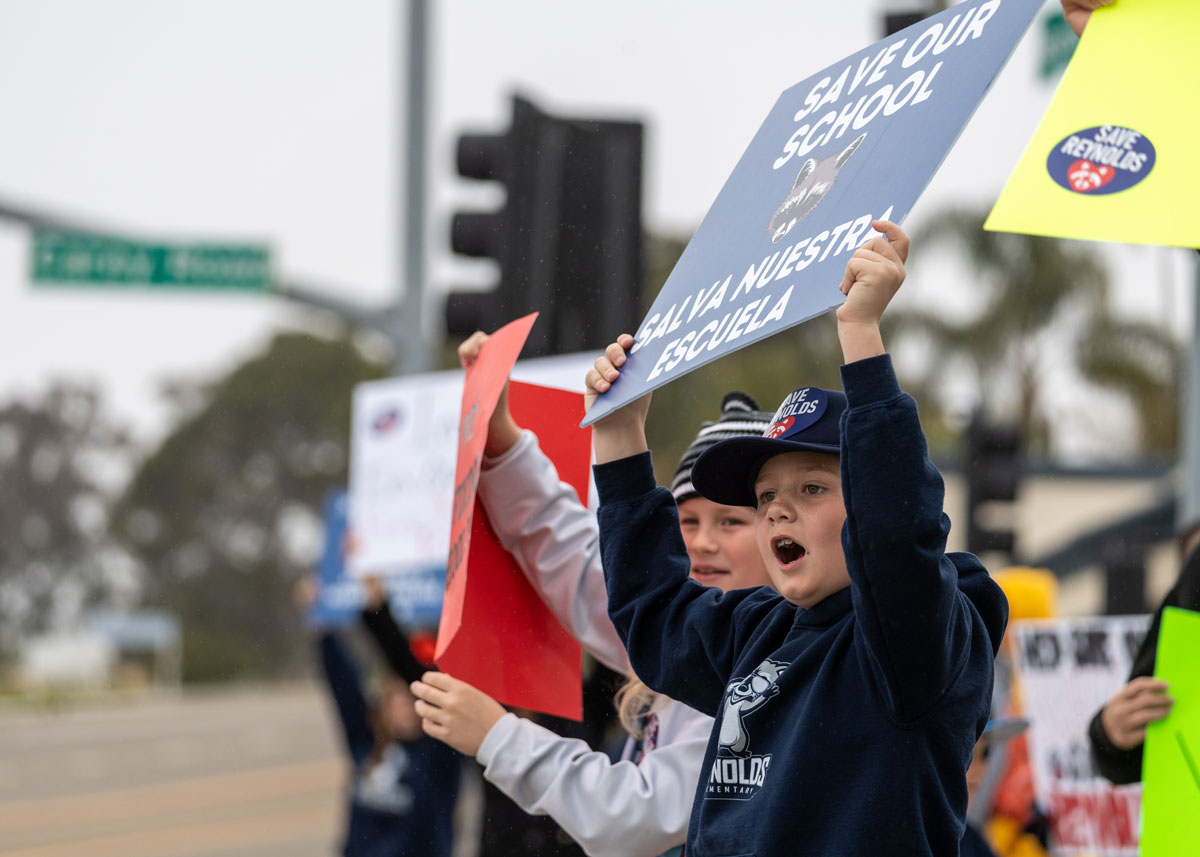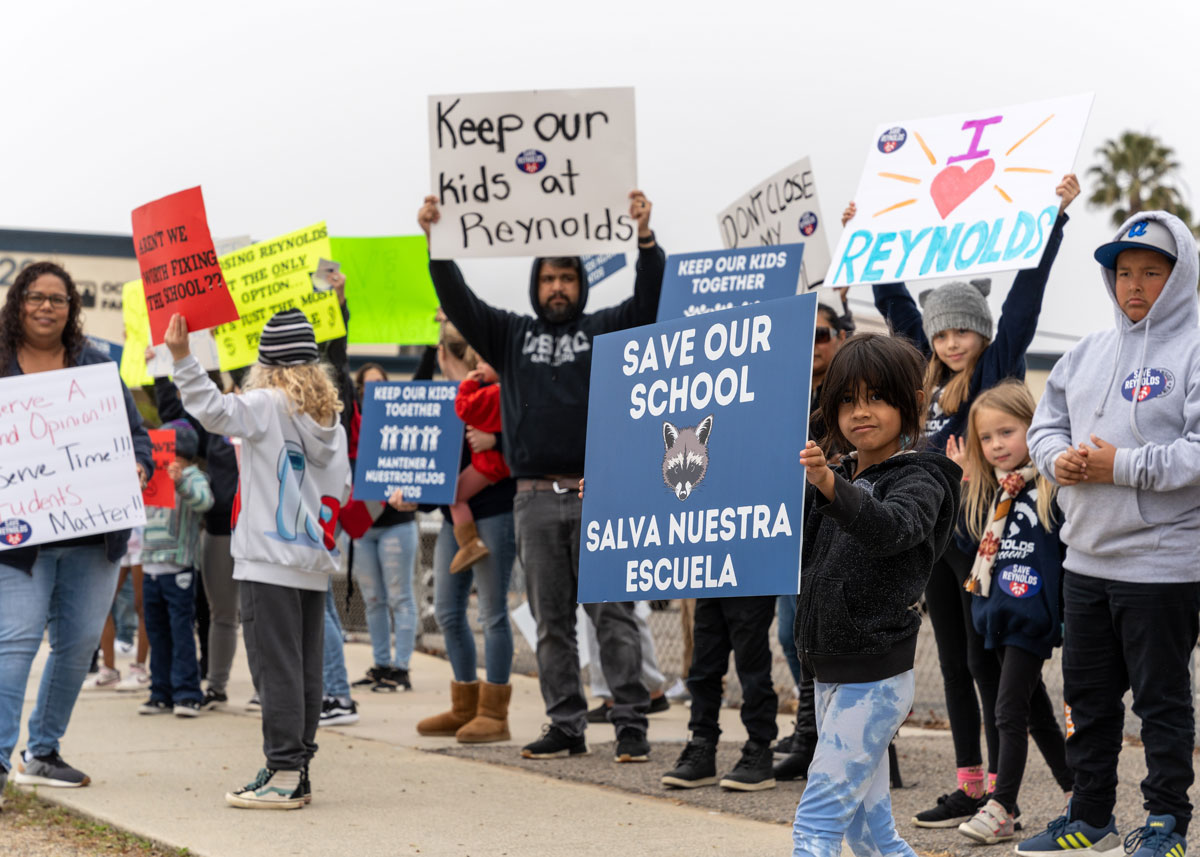OCEANSIDE — Despite the voices of protesting students, parents and staff members last Friday, Reynolds Elementary, serving the Oceanside community for nearly 40 years, is set to close in June due to potentially unstable ground conditions.
The Oceanside Unified School District board voted 3-0-1 to shutter the school during a special March 13 meeting, with Trustee Eleanor Evans abstaining and Trustee Nancy Licona voting against the decision.
Trustees Raquel Alvarez, Stacy Begin and Mike Blessing voted to close the school.
The decision came after district administrators alerted families earlier this month of soil tests that found the campus unsuitable for the school’s planned reconstruction due to the presence of water creating the potential soil liquefaction, a loss of ground strength that causes soil to liquefy in the event of an earthquake.
Staff recommended the district close the school due to potential sinking risks. But parents, students and staff of Reynolds Elementary were furious over the recommendation to close the school, protesting outside of the district office last Friday and packing the meeting hall to demand the district save the school.
MTGL Inc., a geotechnical engineering firm hired to do the mandatory tests as preparation for the school’s modernization project, drilled multiple holes throughout the campus and found water at a depth of 10.5 feet.
The presence of water is likely due to the school’s proximity to the Lake Foss wetland area. Project engineer Daniel Richardson said groundwater levels fluctuate over time due to rainfall and have been recorded even higher at a depth of 8 feet in 1970.

“We have reason to believe it would return to that level,” Richardson told the school board.
Although engineers found the existing buildings to be structurally safe, the facilities are no longer up to code and could sink if an earthquake were to occur.
The County of San Diego identifies the San Luis Rey River Valley, where Reynolds Elementary resides, as within a potential liquefaction hazard zone.
The soil test results found by MTGL were sent to a third party for a second opinion. Reza Saeedzadeh of Atlas Geotechnical told the school board his firm analyzed the unprocessed data and agreed with MTGL’s conclusions.
“The safety of our students and staff is our highest priority both for those attending now and in the future,” said Communications Director Donald Bendz in a statement on behalf of the district. “We know that everyone had their hearts set on modernizing this campus and understand the disappointment the community may be feeling.”
Initially, the school’s modernization project would have cost nearly $49 million to rebuild Reynolds with permanent buildings. The campus, built in 1986, currently consists of primarily portable buildings.
Three possible mitigation solutions were presented to the school board Monday night. First, to mitigate the liquefaction hazard, hundreds of 50-foot stone columns would need to be installed into the ground throughout the campus, costing at least $10 million.
An option would have replaced the old portables with new portables, bringing the total project to $55 million, but this scenario would include something other than new permanent buildings. Other options included potentially rebuilding the site with permanent structures, which would cost approximately $67 million or repairing the existing buildings, which would cost over $100 million.

The community questioned the sudden timing of closing Reynolds just three months after the soil test results were released. Many also questioned the validity of the soil tests. In addition, they felt that the district had ulterior motives for closing the school, such as a desire to sell to housing developers, after an attempt to close the school just two years ago. The district eventually decided to rebuild the school after pushback from the community.
Parents asked that the board postpone its decision to close Reynolds for at least another year or longer.
“This is not an easy problem, but it is being rushed, and we are showing our children that we make these huge decisions, we just rush on through. That is the wrong message to our students,” said Lauren Jones. “We need more time; we need more community involvement in the decisions being put forth in front of you… due diligence has not been shown in this case, and I urge you to please postpone the closing of Reynolds at least for another school year.”
Many parents and staff feared the loss of the school’s Two Way Bilingual Immersion Program, which groups young English language learners in the same classrooms as native English speakers. The district currently has two TWBI programs, one at Reynolds and another at the Pablo Tac School of the Arts.
“The TWBI program at Reynolds will be moved to another school,” Bendz said via email.
Parents also demanded the district spend the extra money to mitigate and repair the school.
The Reynolds reconstruction project would have been funded by Measure W, a voter-approved bond measure that authorizes the district to use up to $160 million in general obligation bonds for facility and grounds improvements at multiple campuses.
Alvarez noted that several other campuses are also in dire need of modernization and repairs under Measure W projects.
Alvarez related to Reynolds parents as she was hesitant to close Garrison Elementary, where her son had previously attended school, in 2019 due to two sinkholes on the campus.
“It took me a long time to go with the board’s decision to say that we needed to move the students,” Alvarez said.
Begin, whose son attended Reynolds, noted that even if the district would go forward with mitigation and reconstruction, students and staff would still need to be moved off campus for up to four years during construction. She also requested that the school community be kept together as much as possible in their move to a new school.
Evans and Licona were hesitant to decide on the closure of Reynolds at the meeting, instead asking to postpone the decision to another special board meeting on March 23, where the district will discuss the new location of the Reynolds community after its closure in June.
At the same meeting, the board will also discuss the ground test results from Del Rio Elementary, where some liquefaction was found in its field. Del Rio and Libby Elementary are potential nearby schools where the Reynolds community could be moved.
Reynolds families who attended the March 13 meeting were heartbroken by the board’s final decision to close the school, many crying and comforting each other, and others angrily yelling at the board and Superintendent Julie Vitale as they left that evening.




